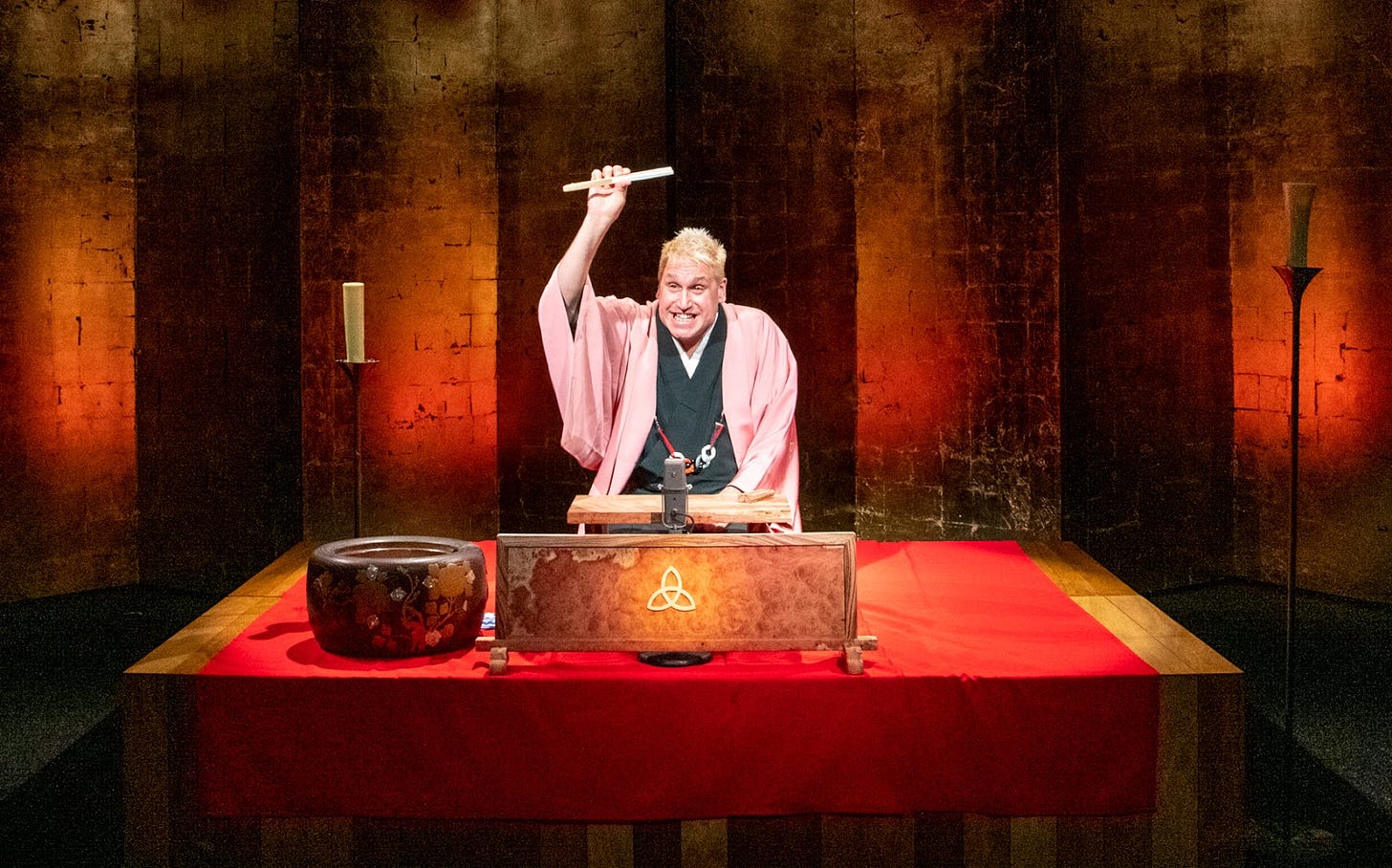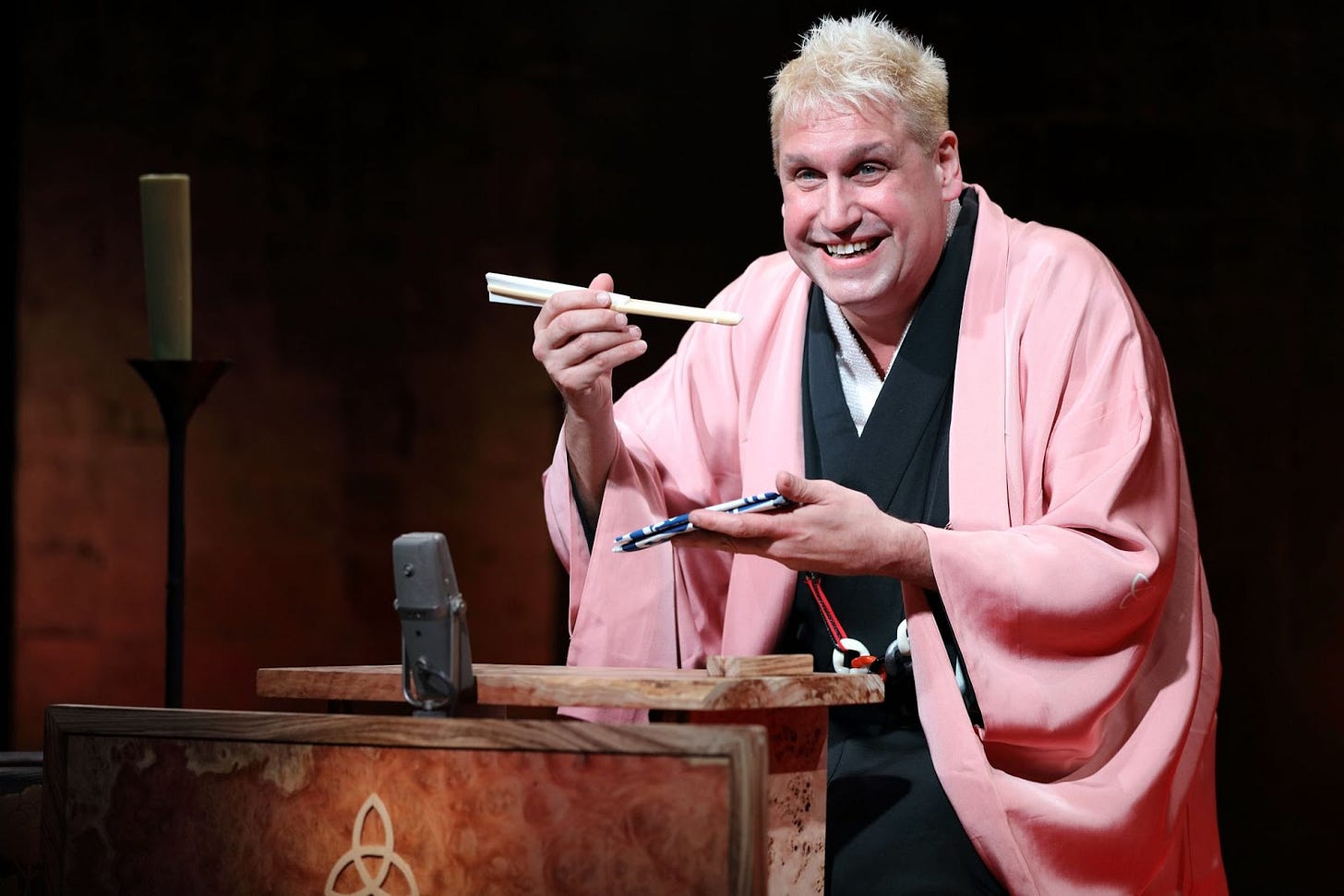Let’s set the scene. It’s 8am BST on a Thursday morning. My video call stutters into action as my London bandwidth struggles to connect to the other line in Tokyo. I can just about make out the words from the person on the other side: “Hi… Sunshine here… good to meet you.” beams the man. I am interviewing the aptly named Katsura Sunshine - the only non-Japanese master of the art form - Rakugo (at time of writing).
Turns out it's excellent timing to be speaking with him. He will soon be performing on Broadway (not for the first time) before a tour of London’s West End. But instead of giving it all away in one swoosh, let’s skip straight to our conversation.
Me: To kick things off, I am sure that our readers would love to know - what is Rakugo?
Sunshine: Rakugo is a 400 year old tradition of Japanese comic storytelling. The stories and the art have been passed down from master to apprentice through the ages up until the present day. There are currently more professional Rakugo storytellers than there ever have been (~1000), divided between Osaka and Tokyo. Each area represents two distinct styles: Kamigata in Osaka and Edo in Tokyo.
Me: And how is the form of a Rakugo show?
Sunshine: The form is very interesting. The first half is a lot like stand-up comedy and is called makura, meaning pillow. It’s your own material that’s a self introduction, self deprecating joke of some kind. This is surrounded by material to warm up the audience and to work them out. You’re observing them, trying to find out which story to pick that is right for the personality of the audience.
Then the second half is the story proper, where you turn your head to the left and play one character, and then to the right and play another character (there is next to no narration in Rakugo). Every story is a long joke that ends in a punchline, which brings it to a satisfying conclusion. A story might go like this:
Me: I can’t help but think of stand-up comedy, how does it compare to this?
Sunshine: There are similarities - especially the first half - the makura. The difference is that Rakugo tends to stay away from controversy, politics and religion. It's clean - the idea behind Rakugo is not to divide the audience but to make everyone in the audience comfortable (young and old). But it’s funny you mention stand-up, as I’m currently raising money for a Netflix comedy special.
Me: Wow! This is music to my ears, can you tell us more?
Sunshine: Absolutely. Some comedians are chosen by Netflix to make a comedy special, while others produce shows first before selling the performance to a broadcaster. I am taking the latter route and am in the midst of fundraising right now. Essentially, Netflix doesn't know that they’re getting a Rakugo comedy special but they’ll take it when they see it. Rakugo cannot be explained, it has to be seen.
Me: I can’t wait to watch this. The news has peaked my interest in how your journey began. What made you go to Japan in the first place?
Sunshine: It’s an interesting story. Twenty years ago, I was working in Toronto as a playwright, composer and producer of musicals. My focus was on ancient Greek comedy (like Aristophanes). And, whilst researching, I came across a scholar that compared ancient Greek comedy with Japanese Kabuki. What fascinated me is there are a ton of similarities between the two, despite the fact that the two cultures definitely never met and the two art forms are separated by millennia.
In today’s world, I probably would have then googled Kabuki, read up on it and continued with my life. But there were no search engines so I thought: “I have to go and see this” and I came to Japan on a working holiday visa. I thought I’d stay for a few months, watch some Kabuki and maybe it will inspire me to write something. But by my 3rd day in Japan I’d already decided that I was never fully going back to Canada.
Me: And then, how did Rakugo draw you in?
Sunshine: I’d been living in Japan for 5 years before I saw a Rakugo for the first time. It was love at first sight and I feel like my life was leading towards that moment. I first saw Rakugo in a little Yakitori shop. I remember there were Japanese lanterns and decorations, there's a cushion, the storyteller is dressed in a kimono and I’m like, “Wow, this feels really Japanese and whatever happens next is going to be very Japanese - I like it already.” And then he (the master) starts cracking up the audience and I’m like, “This is comedy, this is great.” Then he starts acting out the characters and I’m like, “Oh this is theatre - holy smokes! Everything that I’ve ever loved is concentrated into one art form: ancient stuff, comedy, theatre and Japan.”
Me: And then you began to study it I suppose. What was it like being a Rakugo apprentice?
Sunshine: I studied Rakugo casually for 3 years before asking my master, Katsura Bunshi VI, to take me on as an apprentice. The apprenticeship lasts for 3 years and is pretty heavy. It is everyday at his house doing the cleaning, doing the laundry, cooking, folding kimonos and any other menial chores.
And then it’s you tagging along with your master as staff to all of his Rakugo shows. This includes looking after his dressing room, the senior guests, laying out his Kimonos, helping him dress, preparing tea, operating light, sound and stage managerial work. Then you sit at the side of the stage and observe. In fact there is a specific phrase for this in Japanese which literally translates to ‘steal the craft’.
Me: How long before you start performing as an apprentice?
Sunshine: As soon as you learn one story during your apprenticeship, your master will put you in front of an audience as a warm up act to his main show. You’ll go out and inevitably bomb as you’re only an apprentice. You still have a lot to learn and, of course, you improve with time and teaching.
Me: And now as a professional, how do you keep coming up with material?
Sunshine: I start by getting inspiration from the world around me. I take an experience I’ve had which I think is funny, I mould it a little bit and it becomes material for the stage. Through my training I was able to grow antennae that helped me to analyse every little interaction I have and measure it into a Rakugo story. Then I’ll test each joke or anecdote whilst drinking with my friends to see what they find funny. Incidentally the simplicity to Rakugo is one of the reasons why Rakugo has not changed in centuries.
Me: Incredible. What advice would you give to anyone wanting to practice Rakugo?
Sunshine: Number one, go to Japan and learn the language before you do anything else. To understand the nuance, you really need a certain level of Japanese context.
Me: Wow - look at the time - it seems we’ve run out of it. Thank you so much for taking the time to talk to me Sunshine. To our esteemed readers, if you are interested in buying tickets to Sunshine’s upcoming shows, please visit his website: www.rakugo.lol. He also owns a line of kimonos: www.kimonodenim.com which I now seriously need in my life.
Sunshine: Thank you for having me. I look forward to seeing you all at my shows.




I hope Netflix picks up his special so that the whole world can be introduced to Rakugo! Also, that apprenticeship sounds insane. You have to really want it!